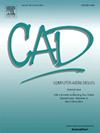A salient vector field-driven part orientation selection for multi-axis 3D printing
IF 3.1
3区 计算机科学
Q2 COMPUTER SCIENCE, SOFTWARE ENGINEERING
引用次数: 0
Abstract
Part orientation is a crucial element that governs the impact of several manufacturing constraints in material extrusion-based additive manufacturing (AM). Although part orientation optimisation has been extensively investigated to improve the manufacturability in 2.5-axis AM configuration, its influence on material extrusion-based multi-axis AM remains underdetermined. In this paper, we propose a computational framework to find the optimal part orientation that maximises the compliance of the tool orientation vector field with respect to several constraints required for support-free multi-axis AM. By combining topological significance, mesh saliency and curvedness metrics, we introduce a new salient feature map to formulate the link between the part orientation and the tool orientation vector field compliance. Once the optimal orientation is computed, our method enables a direct computation of a compliant iso-tool orientation vector field for a set of input iso-tool path points. We demonstrate that the part orientation can indeed be changed to minimise tool angle variation whilst adhering to overhang angle constraints for a range of 3D mesh models. The effectiveness of the proposed method is validated by comparing our method with existing tool orientation vector field design methods. Our promising results reveal the potential in part orientation optimisation as a means to address manufacturing constraints in multi-axis tool path design.
面向多轴3D打印的显著矢量场驱动零件方向选择
在基于材料挤压的增材制造(AM)中,零件方向是决定几个制造约束影响的关键因素。尽管为了提高2.5轴增材制造配置的可制造性,零件取向优化已经得到了广泛的研究,但其对基于材料挤压的多轴增材制造的影响仍未确定。在本文中,我们提出了一个计算框架,以找到最佳的零件方向,最大限度地提高了刀具方向矢量场的顺应性,相对于无支撑多轴增材制造所需的几个约束。通过结合拓扑显著性、网格显著性和曲率度量,引入了一种新的显著特征映射,以建立零件方向与刀具方向矢量场柔度之间的联系。一旦计算出最佳方向,我们的方法就可以直接计算一组输入等刀路径点的柔性等刀方向向量场。我们证明,零件方向确实可以改变,以尽量减少刀具角度变化,同时坚持对一系列3D网格模型的悬垂角约束。通过与现有刀具方向矢量场设计方法的比较,验证了该方法的有效性。我们有希望的结果揭示了零件定向优化作为解决多轴刀具路径设计中制造限制的一种手段的潜力。
本文章由计算机程序翻译,如有差异,请以英文原文为准。
求助全文
约1分钟内获得全文
求助全文
来源期刊

Computer-Aided Design
工程技术-计算机:软件工程
CiteScore
5.50
自引率
4.70%
发文量
117
审稿时长
4.2 months
期刊介绍:
Computer-Aided Design is a leading international journal that provides academia and industry with key papers on research and developments in the application of computers to design.
Computer-Aided Design invites papers reporting new research, as well as novel or particularly significant applications, within a wide range of topics, spanning all stages of design process from concept creation to manufacture and beyond.
 求助内容:
求助内容: 应助结果提醒方式:
应助结果提醒方式:


